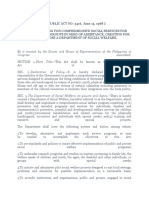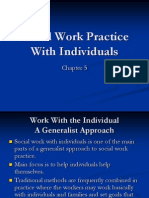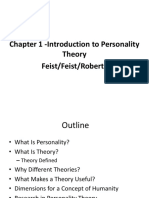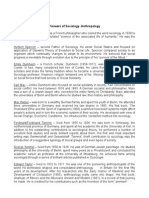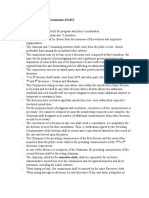Deviation, Social Problems, and Control
Deviation, Social Problems, and Control
Uploaded by
mark gaurano0 ratings0% found this document useful (0 votes)
33 views15 pagesThe document discusses the meaning and nature of deviance and provides theoretical explanations for deviance. It defines deviance as a violation of social norms and expectations. It notes that deviance can have both positive and negative effects on individuals and society. Several major theories that seek to explain deviance are outlined, including structural functionalism, social strain theory, symbolic interactionism, and conflict theory. Each theory proposes different causes for why individuals engage in deviant behavior.
Original Description:
social deviance leads to violation of social rules and norms
Original Title
deviation
Copyright
© © All Rights Reserved
Available Formats
PPTX, PDF, TXT or read online from Scribd
Share this document
Did you find this document useful?
Is this content inappropriate?
The document discusses the meaning and nature of deviance and provides theoretical explanations for deviance. It defines deviance as a violation of social norms and expectations. It notes that deviance can have both positive and negative effects on individuals and society. Several major theories that seek to explain deviance are outlined, including structural functionalism, social strain theory, symbolic interactionism, and conflict theory. Each theory proposes different causes for why individuals engage in deviant behavior.
Copyright:
© All Rights Reserved
Available Formats
Download as PPTX, PDF, TXT or read online from Scribd
Download as pptx, pdf, or txt
0 ratings0% found this document useful (0 votes)
33 views15 pagesDeviation, Social Problems, and Control
Deviation, Social Problems, and Control
Uploaded by
mark gauranoThe document discusses the meaning and nature of deviance and provides theoretical explanations for deviance. It defines deviance as a violation of social norms and expectations. It notes that deviance can have both positive and negative effects on individuals and society. Several major theories that seek to explain deviance are outlined, including structural functionalism, social strain theory, symbolic interactionism, and conflict theory. Each theory proposes different causes for why individuals engage in deviant behavior.
Copyright:
© All Rights Reserved
Available Formats
Download as PPTX, PDF, TXT or read online from Scribd
Download as pptx, pdf, or txt
You are on page 1of 15
Deviation, Social
Problems, and Control
Lesson 1: Meaning of Nature and
Deviance
Deviance, is violation of social rules and
conventions.
When a certain individuals fails to act
according to the norms and expectations of
society, he/she referred to as deviant.
Deviance has always negative connotation;
People usually get annoyed easily by deviant
behavior.
Consequence of Deviance
Deviance has positive and negative effects on individuals and
society. Some of its positive effects are as follows:
* It teaches people what acceptable social behavior is.
* It strengthens group norms and values.
* It is a sign and a source of social change.
Some of its negative effects are the ff:
* It harms group stability.
* It induces distrust and ill will.
* It drains human and economic resources.
* It weakens people’s faith in and conformity to social
norms
Social Tolerance of Deviance
Why do people deviate from social norms?
Reactions to deviance vary by
intensity. Violations of some norms of
etiquette, for instance, may meet with only
mild disapproval and sanctions, whereas
violations of the rule of law such as murder,
rape, or robbery may receive strong
condemnation and severe punishment.
Deviance as Relative
Deviance is relative in nature. It depends
upon the cultural norms. An individual
appears deviant because other people see
his/her that way.
Deviance relies on how people interpret
social behavior.
Lesson 2: Theoretical
Explanations of Deviance
Theoretical Explanation of Deviance
Some of the most familiar theories that explain
deviance are the ff:
* Structural – Functional View
* Social Strain Theory
* Symbolic – Interaction Theory
* Conflict Theory
A. Structural – Functional View
Under this perspective, People deviate from given social norms because
of the rapid social changes that are taking place.
Structural – Functional View, sees society as a structure with interrelated
parts designed to meet the biological and social needs of the individuals
in that society.
Émile Durkheim, another early sociologist, applied Spencer’s theory to
explain how societies change and survive over time. Durkheim believed
that society is a complex system of interrelated and interdependent parts
that work together to maintain stability (Durkheim 1893), and that
society is held together by shared values, languages, and symbols.
He believed that to study society, a sociologist must look beyond
individuals to social facts such as laws, morals, values, religious beliefs,
customs, fashion, and rituals, which all serve to govern social life.
B. Social Strain Theory
Strain theory explains deviant behavior as an inevitable outcome of
the strain individuals experience when society does not provide
adequate and approved means to achieve culturally valued goals.
For example, when a society places cultural value on economic
success and wealth, but only provides legally sanctioned means for a
small portion of the population to achieve these goals, those excluded
may turn to unconventional or criminal means of attaining them.
Strain theory was developed by American sociologist Robert K.
Merton. It is rooted in the functionalist perspective on deviance and
connected to Émile Durkheim's theory.
In Merton's theory of strain, societies are composed of two core
aspects: culture and social structure.
Four Ways of Responding to Strain
Innovation
Is a mode in which an individual acknowledges society’s goal, but
his/her from attaining such goal via legal or legitimate means.
Retreatism: When people both reject the culturally valued goals of a
society and the legitimate means of attaining them and live their lives in
a way that evades participation in both, they can be described as
retreating from society.
Rebellion: This applies to people and groups that both reject the
culturally valued goals of a society and the legitimate means of attaining
them, but instead of retreating, work to replace both with different goals
and means.
Ritualism: This describes those who pursue the legitimate means of
attaining goals, but who set more humble and achievable goals for
themselves.
C. Symbolic – Interaction Theory
This Paradigm States that deviance is learned through
interaction with other deviant people and involves in the
development of a deviant concept.
Four Sub Theories:
Differential Association Theory
It state here that, “the more contact a person has with
people who commit deviant acts, the more likely that
person is to engage in deviant activities.
Edwin Sutherland (1961) suggested that all human
behavior including deviance, is learned through association
with others, especially groups.
Self – Esteem Theory
It state here that people deviance or conformity depending on
which will do the most to enhance their self esteem.
Control Theory
Develop by Travis Hirschi, Suggest that deviance arises from
particular social arrangements, specifically inability of society
to control adequately the activities of its members.
Four types of social control
1. Attachment
2. Commitment
3. Involvement
4. Believe –Strong Believe
Labeling Theory
Accdg to this theory, deviance is a result of being labeled by
society Howard Becker (1973). He state that social groups
create deviance by making the rules whose infraction
constitutes deviance, and by applying these rules to
particular people and labeling them as outsiders.
D. Conflict Theory
Accdg to this theory, Social inequality is the root of numerous social problems
such as deviance and crime.
Macionis (2007) cited three ways of explaining the social conflict theory of
deviance.
First – it is the interest of those in charge, The rich and powerful which are
reflected in any society’s law and norms. Those who threaten their wealth or
power are labeled as criminals. The justice system is designed by the ruling
class to work for the ruling class, and against the working class and the poor.
Second, The ruling class has enough power to keep themselves from being
labeled as deviant; those involved in scandals are rarely arrested or sent in
jail.
Third, People tend to be concerned over the fact that laws are not applied
equally in all members of society.
Functions of Deviance
Deviance promotes social unity. It tells what most people
expect.
It affirms cultural values and norms.
It clarifies moral boundaries.
It encourage social change.
It provides jobs from people (policemen, Lawyers,
Psychologist, etc.)
It provide safety valve for society.
You might also like
- Full Download Ebook Ebook PDF Nakama 1 Enhanced Student Text Introductory Japanese Communication Culture Context 3rd Edition PDFDocument42 pagesFull Download Ebook Ebook PDF Nakama 1 Enhanced Student Text Introductory Japanese Communication Culture Context 3rd Edition PDFcarolyn.hutchins98395% (44)
- Filipino Personality and Social WorkDocument55 pagesFilipino Personality and Social WorkRomy VelascoNoch keine Bewertungen
- Social Work Recording and Reporting Writing 1Document46 pagesSocial Work Recording and Reporting Writing 1Hayya DibarosanNoch keine Bewertungen
- Social Psychology ReflectionDocument3 pagesSocial Psychology Reflectionapi-325740487Noch keine Bewertungen
- (Biology and Ecology of Marine Life) David, Sheba Rani Nakka - Ramesh, Santhanam - Santhanam, Ramasamy - Biology and Ecology of Pharmaceutical Marine Life - echinoderms-CRC Press (20 PDFDocument435 pages(Biology and Ecology of Marine Life) David, Sheba Rani Nakka - Ramesh, Santhanam - Santhanam, Ramasamy - Biology and Ecology of Pharmaceutical Marine Life - echinoderms-CRC Press (20 PDFEmilio Lecaros Bustamante100% (1)
- 2-Salesforce - CRM Basics (1 Day)Document3 pages2-Salesforce - CRM Basics (1 Day)abhi74Noch keine Bewertungen
- Choice Theory of Planning and Advocacy and Pluralism in PlanningDocument24 pagesChoice Theory of Planning and Advocacy and Pluralism in PlanningAre PeaceNoch keine Bewertungen
- Ra 9433Document10 pagesRa 9433brielNoch keine Bewertungen
- Law Abiding CitizenDocument2 pagesLaw Abiding CitizenJojie SharinaNoch keine Bewertungen
- Social DeviationDocument12 pagesSocial DeviationJeremiah MagcalasNoch keine Bewertungen
- 30 G.R. No. 147405 April 25, 2006 Platinum Plans Phil. Inc Vs CucuecoDocument6 pages30 G.R. No. 147405 April 25, 2006 Platinum Plans Phil. Inc Vs CucuecorodolfoverdidajrNoch keine Bewertungen
- SW-105-SYLLABUS For FILIPINO-PERSONALITY-AND-SOCIAL-WORKDocument5 pagesSW-105-SYLLABUS For FILIPINO-PERSONALITY-AND-SOCIAL-WORKHafsah ArnorolNoch keine Bewertungen
- SW185 CounselingDocument9 pagesSW185 CounselingHafsah ArnorolNoch keine Bewertungen
- Administrative Law Nature of Administrative LawDocument8 pagesAdministrative Law Nature of Administrative LawSHEKINAHFAITH REQUINTELNoch keine Bewertungen
- Filipino Personality and Social Work Hbe123Document4 pagesFilipino Personality and Social Work Hbe123Norwafa Cariga EspinosaNoch keine Bewertungen
- Counseling LectureDocument24 pagesCounseling LectureDennis RaymundoNoch keine Bewertungen
- CD1Document42 pagesCD1Bernadette Lou LasinNoch keine Bewertungen
- Community OrganizingDocument47 pagesCommunity OrganizingKATE LAWRENCE BITANTOSNoch keine Bewertungen
- Introduction To Gender and Society (Chapter 1 and 2)Document3 pagesIntroduction To Gender and Society (Chapter 1 and 2)Nikko L. Pescueso0% (1)
- Ra 5416Document6 pagesRa 5416Bea SerranoNoch keine Bewertungen
- Social Work Practice With IndividualsDocument56 pagesSocial Work Practice With IndividualsAngel Marie LlanitaNoch keine Bewertungen
- Freedom and MoraltyDocument5 pagesFreedom and MoraltyJhon Walter Ortega CondeNoch keine Bewertungen
- Lyceum of The Philippines University CaviteDocument37 pagesLyceum of The Philippines University CaviteJamila Irish Masinas0% (1)
- Communication in Organization ULDocument48 pagesCommunication in Organization ULMubarak Hussain Haider100% (1)
- RrcyDocument466 pagesRrcyShekinah MizpahNoch keine Bewertungen
- Social Work ResearchDocument5 pagesSocial Work Researchsweetdianne.veronaNoch keine Bewertungen
- Social Work Practice With Individuals and FamiliesDocument36 pagesSocial Work Practice With Individuals and FamiliesArcelyn BasiliscoNoch keine Bewertungen
- Products and ServicesDocument31 pagesProducts and ServicesJason CNoch keine Bewertungen
- Difference Between Probation and ParoleDocument2 pagesDifference Between Probation and ParolekashifrazamangiNoch keine Bewertungen
- Womens MonthDocument23 pagesWomens MonthShelene Cathlyn Borja Daga-asNoch keine Bewertungen
- Counseling ReviewerDocument7 pagesCounseling ReviewerSHIELA SAMANTHA SANTOSNoch keine Bewertungen
- Mental Health in The Workplace SampleDocument2 pagesMental Health in The Workplace Sampleriza delloroNoch keine Bewertungen
- Hbse Filipino PersonalityDocument9 pagesHbse Filipino Personalityn.alioden02Noch keine Bewertungen
- Philippine RealitiesDocument125 pagesPhilippine RealitiesAira MaeNoch keine Bewertungen
- Social Work Practice With GroupsDocument24 pagesSocial Work Practice With GroupsCRYSTAL VINE DELA ROSANoch keine Bewertungen
- Reviewer SWP-107Document22 pagesReviewer SWP-107Sean C.A.ENoch keine Bewertungen
- Orange Book Summary Social Welfare and Social Work 1 1Document36 pagesOrange Book Summary Social Welfare and Social Work 1 1Ann MustapaNoch keine Bewertungen
- Situation Factors That Affect ConformityDocument4 pagesSituation Factors That Affect ConformityKayleigh EdwardsNoch keine Bewertungen
- Chapter 3 - UTS (Anthropological Perspective)Document26 pagesChapter 3 - UTS (Anthropological Perspective)James CancinoNoch keine Bewertungen
- Social Work Practice With IndividualsDocument37 pagesSocial Work Practice With Individualsমোঃ সাইদুর রহিম67% (3)
- Sample Covenant AgreementDocument3 pagesSample Covenant AgreementA B100% (1)
- Handouts For GovermentDocument4 pagesHandouts For GovermentDhie-dhie Delgado-LayloNoch keine Bewertungen
- Introduction To ContractsDocument16 pagesIntroduction To ContractsKavit TrehabNoch keine Bewertungen
- Attributes of SW ProfessionDocument17 pagesAttributes of SW ProfessionArumpac, Norjanah T.Noch keine Bewertungen
- Benguet State University: College of NursingDocument1 pageBenguet State University: College of Nursingdusty kawiNoch keine Bewertungen
- Chapter 2 The Sociological Perspective of The Self e ModuleDocument11 pagesChapter 2 The Sociological Perspective of The Self e ModuleLois Alzette Rivera AlbaoNoch keine Bewertungen
- Equality VS Equity Ppt. 1Document13 pagesEquality VS Equity Ppt. 1Rhofa Mae Acevedo100% (1)
- Intro To TopDocument21 pagesIntro To TopPduys16Noch keine Bewertungen
- Freedom of Expression V Freedom of Religion The Case of Carlos CeldranDocument13 pagesFreedom of Expression V Freedom of Religion The Case of Carlos CeldranangelomoragaNoch keine Bewertungen
- SocioAnthro PioneersDocument2 pagesSocioAnthro PioneersGraciella De GuzmanNoch keine Bewertungen
- Determinants of Human BehaviorDocument12 pagesDeterminants of Human BehaviorAnaoj28Noch keine Bewertungen
- DCTRCDDDocument6 pagesDCTRCDDbubblingbrookNoch keine Bewertungen
- Sustainable Development GoalsDocument16 pagesSustainable Development GoalsAizel EstolanoNoch keine Bewertungen
- Article 220 - : National Labor Relations Commission (NLRC)Document6 pagesArticle 220 - : National Labor Relations Commission (NLRC)Maan L. Ferrer-VillegasNoch keine Bewertungen
- Cflm1 - For ReviewDocument178 pagesCflm1 - For ReviewJoebert SalvillaNoch keine Bewertungen
- Globalization and Social WorkDocument49 pagesGlobalization and Social Workbebutterfly97100% (1)
- Social Systems & Organizational CultureDocument61 pagesSocial Systems & Organizational CultureClaribelle Haber100% (1)
- Community ParticipationDocument3 pagesCommunity ParticipationKavya100% (1)
- Filipino Personality and Social WorkDocument83 pagesFilipino Personality and Social WorkChristian C. NabuaNoch keine Bewertungen
- DevianceDocument14 pagesDevianceFarah NoreenNoch keine Bewertungen
- 9 Deviance and Social ControlDocument7 pages9 Deviance and Social ControlEmmanuel S. CaliwanNoch keine Bewertungen
- Theories of DeviationDocument15 pagesTheories of Deviationfnyonga7Noch keine Bewertungen
- Housing ReviewerDocument9 pagesHousing Reviewermark gauranoNoch keine Bewertungen
- Developing The Project Plan: Group 3Document18 pagesDeveloping The Project Plan: Group 3mark gauranoNoch keine Bewertungen
- Net TechDocument15 pagesNet Techmark gauranoNoch keine Bewertungen
- Construction ManagementDocument19 pagesConstruction Managementmark gauranoNoch keine Bewertungen
- Primary Mental Abilities 1Document10 pagesPrimary Mental Abilities 1Man DezNoch keine Bewertungen
- Enclosure CatalogDocument74 pagesEnclosure Catalogmirceadanila20053264Noch keine Bewertungen
- Simple Future (Will)Document30 pagesSimple Future (Will)Luiz HenriqueNoch keine Bewertungen
- Main Parts of Speech: o o o o o o o oDocument63 pagesMain Parts of Speech: o o o o o o o oNhi HuynhNoch keine Bewertungen
- Master's Thesis - Final DraftDocument288 pagesMaster's Thesis - Final DraftAmbrishNoch keine Bewertungen
- Microsoft 70 534Document76 pagesMicrosoft 70 534Kanak TripathiNoch keine Bewertungen
- Dynamics - Chapter 13 (Beer7)Document68 pagesDynamics - Chapter 13 (Beer7)api-370949689% (9)
- Analytical Dynamics of Variable-Mass SystemDocument11 pagesAnalytical Dynamics of Variable-Mass SystemIshmael Hossain SheikhNoch keine Bewertungen
- Summative in Physical Science 4th QDocument4 pagesSummative in Physical Science 4th QJoelynBitosNoch keine Bewertungen
- 12th November, 2021 Daily Global Regionl Local Rice E-NewsletterDocument38 pages12th November, 2021 Daily Global Regionl Local Rice E-NewsletterMujahid AliNoch keine Bewertungen
- Corporate Governance: Theory and Practice: Dr. Malek Lashgari, CFA, University of Hartford, West Hartford, CTDocument7 pagesCorporate Governance: Theory and Practice: Dr. Malek Lashgari, CFA, University of Hartford, West Hartford, CTNaod MekonnenNoch keine Bewertungen
- R4 - Lesson 9 - A Call To ActionDocument12 pagesR4 - Lesson 9 - A Call To ActionKyle HoonNoch keine Bewertungen
- 273 Branchport Ave. Long Branch, N.J. 07740 (800) 631-2148Document2 pages273 Branchport Ave. Long Branch, N.J. 07740 (800) 631-2148thoufiqNoch keine Bewertungen
- Edwards Signaling 116EXC Data SheetDocument4 pagesEdwards Signaling 116EXC Data SheetJMAC SupplyNoch keine Bewertungen
- Simplexity PRD Template Sept 2022Document12 pagesSimplexity PRD Template Sept 2022Iqra RamzanNoch keine Bewertungen
- Resume of Yelly2danniDocument1 pageResume of Yelly2danniapi-31704300Noch keine Bewertungen
- Tabuk District-1: Monitoring, Evaluation & Adjustment Quarterly MonitoringDocument22 pagesTabuk District-1: Monitoring, Evaluation & Adjustment Quarterly Monitoringjoan dalilisNoch keine Bewertungen
- Mpp2 SPM Paper 4 2021 (Kertas Soalan)Document6 pagesMpp2 SPM Paper 4 2021 (Kertas Soalan)Azly M SabinNoch keine Bewertungen
- Week2 - Set 4 (Thursday)Document3 pagesWeek2 - Set 4 (Thursday)Yash MotianiNoch keine Bewertungen
- Allama Iqbal Open University Islamabad: Book Name (8612) Level: B.EdDocument9 pagesAllama Iqbal Open University Islamabad: Book Name (8612) Level: B.EdArshad SanwalNoch keine Bewertungen
- HW1 SolDocument8 pagesHW1 SolKuangye ChenNoch keine Bewertungen
- ICT Lab Manual - Lab Experiment CompleteDocument58 pagesICT Lab Manual - Lab Experiment CompleteNasir Ali / Lab Engineer, Electrical Engineering DepartmentNoch keine Bewertungen
- Department Guide BookDocument23 pagesDepartment Guide BookRajat KumarNoch keine Bewertungen
- CI Pamphlet 168Document40 pagesCI Pamphlet 168Cyrix.OneNoch keine Bewertungen
- Report On Native Konbac Bamboo Product Private LimitedDocument3 pagesReport On Native Konbac Bamboo Product Private LimitedSuprio SahaNoch keine Bewertungen
- Feasibility StudyDocument21 pagesFeasibility StudySerge Olivier Atchu Yudom67% (3)
- 7b Kobelco CKE800-1F - SpecDocument16 pages7b Kobelco CKE800-1F - SpecLim Lion Yee100% (1)



















